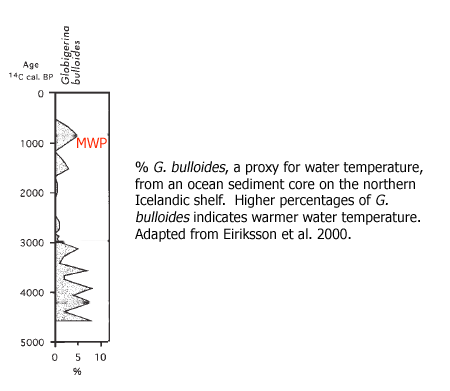Northern Icelandic Shelf, North Atlantic Ocean
Reference
Eiríksson, J., Knudsen, K.L., Haflidason, H. and Heinemeier, J. 2000. Chronology of late Holocene climatic events in the northern North Atlantic based on AMS 14C dates and tephra markers from the volcano Hekla, Iceland. Journal of Quaternary Science 15: 573-580.
Reference
Eiríksson, J., Knudsen, K.L., Haflidason, H. and Heinemeier, J. 2000. Chronology of late Holocene climatic events in the northern North Atlantic based on AMS 14C dates and tephra markers from the volcano Hekla, Iceland. Journal of Quaternary Science 15: 573-580.
Description
Planktonic foraminiferal abundances derived from an ocean sediment core retrieved from the northern Icelandic shelf in the north Atlantic Ocean (~66.45°N, 19°W) were used as a temperature proxy for this region over the past 4600 years. Higher temperatures during the Medieval Warm Period (~900-1300 A.D.) were inferred from higher concentrations of Globigerina bulloides, a warm-water planktonic species. Because concentrations of G. bulloides declined to zero during the Little Ice Age and have "not returned to the area after the Little Ice Age," we conclude that temperatures of the Current Warm Period have not yet reached the level of those of the MWP.





